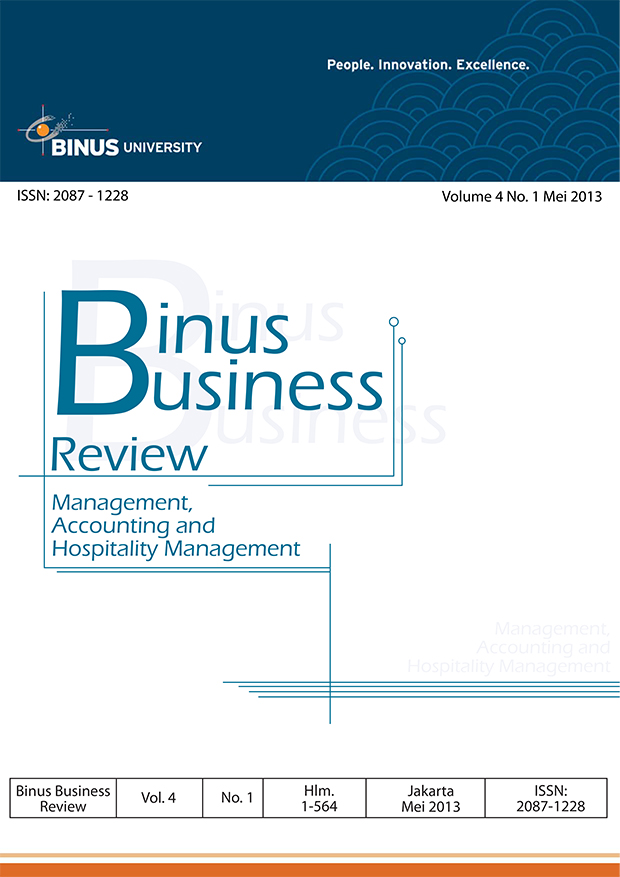Analisis Matriks Boston Consulting Group (BCG) untuk Memenangkan Strategi Organisasi (Studi Kasus Perguruan Tinggi Di Kopertis Wilayah III – DKI Jakarta)
DOI:
https://doi.org/10.21512/bbr.v4i1.1407Keywords:
BCG, Matrix, Kopertis region III-DKI Jakarta, higher educationAbstract
This research intends to know position of market growth in higher education, especially Sekolah Tinggi, based on market share, using BCG metrics. Unit analysis is all private higher educations in Kopertis III – DKI Jakarta, consisting of University, Sekolah Tinggi, Institute, and Academics. The object of analysis is the numberof new student admission. Method of data collection in this paper is field research including observation and literature research method. The secondary data used in this study is data from Kopertis region III. Based on the results of the study, it is obtained Sekolah Tinggi for the academic year 2008 and 2009 is in quadrant III (Cash Cow).
References
Barnett, R. A. (1990). The Idea Of Higher Education. London: Open University Press.
Barnett, R.A. (1994). The Limits of Competence: Knowledge, Higher Education and Society. London: Open University Press.
Bettis, R. A. & Hall, W. K. (1981). Strategic Portfolio Management in the Multibusiness Firm. California Management Review, 24(1): 23-38.
David, F. R. (2006). Manajemen Strategis, Konsep. Edisi 10 (terjemahan). Buku 1. Jakarta: Salemba Empat.
Direktori Perguruan Tinggi Swasta Kopertis Wilayah III – Jakarta tahun 2008, Departemen Pendidikan Nasional.
Hambrick, D. C., MacMillan, I. C., and Day, D. L. (1982). Strategic Attributes and Performance in the BCG Matrix--A PIMS-Based Analysis of Industrial Product Businesses. Academy of Management Journal. Vol 25, no. 3, 510 531.
Hitt, M.A., Ireland, R. D., & Hoskisson,R.E. (2001). Strategic management:competitiveness and globalization. 4th ed. Cincinnati, Ohio: South-Western College Publishing/Thomson Learning. http://faculty.unlv.edu/phelan/Research/BCG.pdf - BPSPAP12482 (diakses 11 Januari 2013).
Human, G., and Naudé, P. (2009). Exploring The Relationship between Network Competence, Network Capability and Firm Performance: A Resource-Based Perspective in an Emerging Economy. Journal Management Dynamics. Vol. 18, No. 1, 2009.
Ishikawa, I. (2008). The Source of Competitive Advantage and Entrepreneurial Judgment in the Resource-based View: Insights from the Austrian School Perspective, Journal of Strategic Management Education 4: 91-116. Senate Hall Academic Publishing.
Ivy, J. (2001). Higher Education Institution: a Correspondence Analysis approach. The International Journal of Educational Management, 15(6/7).
Kementerian Pendidikan Nasional, (2010), Direktori Perguruan Tinggi Swasta, Kopertis Wilayah III, Jakarta, Kopertis Wilayah III, Jakarta.
Klein, A. (2011). Corporate Culture: Its Value as a Resource for Competitive Advantage. Journal of Business Strategy, Vol. 32, No. 2, pp. 21-28. ISSN 0275-6668.
Lakitan, B. (2012). Riset untuk peningkatan daya saing Perguruan Tinggi. Rakornas Penelitian dan Pengabdian Kepada Masyarakat, Kementrian Pendidikan dan Kebudayaan, Yogyakarta, 20 Januari 2012.
Nizam. (2012). Pengembangan pendidikan tinggi, untuk kemandirian dan daya saing bangsa , Sekretaris Dewan Pendidikan Tinggi, Rakornas, Kemendikbud, Yogyakarta.
O’Cass, A., Voola, R. (2011). Explications of Political Market Orientation and Political Brand Orientation Using the Resource-based View of the Political Party. Journal of Marketing Management. Vol. 27, Nos. 5-6, May, pp. 627-745. pada CV. Turangga Mas Motor. Jakarta: Skripsi, Universitas Guna Darma.
Peteraf, M. A. (1993). The Cornerstones of Competitive Advantage: a Resource-based view. Strategic Management Journal. Vol. 14, No. 3, pp. 179–191.
Porter, M. E. (1985). Competitive Advantage: Creating and sustaining, superior performance, e-book, the free press.
Rangkuti, F. (2006). Analisis SWOT Teknik Membedah Kasus Bisnis. Jakarta: Gramedia Pustaka Utama.
Sekaran, U., and Bougie, R. (2009). Research Methods for Business, A Skill Building Approach. Fifth edition. United Kingdom: John Wiley & Sons.
The BCG Matrix revisited: A computational approach
Tilaar, H., A. R. (2008). Agenda Pendidikan Nasioanl dalam Perspektif Abad 21. Yogyakarta: Terra, Indonesia.
Widyatmini dan Fajar, M. F. (2008). Analisis Matriks BCG pada Strategi Pemasaran Produk
Downloads
Published
How to Cite
Issue
Section
License
Authors who publish with this journal agree to the following terms:
a. Authors retain copyright and grant the journal right of first publication with the work simultaneously licensed under a Creative Commons Attribution License - Share Alike that allows others to share the work with an acknowledgment of the work's authorship and initial publication in this journal.
b. Authors are able to enter into separate, additional contractual arrangements for the non-exclusive distribution of the journal's published version of the work (e.g., post it to an institutional repository or publish it in a book), with an acknowledgment of its initial publication in this journal.
c. Authors are permitted and encouraged to post their work online (e.g., in institutional repositories or on their website) prior to and during the submission process, as it can lead to productive exchanges, as well as earlier and greater citation of published work.
USER RIGHTS
All articles published Open Access will be immediately and permanently free for everyone to read and download. We are continuously working with our author communities to select the best choice of license options, currently being defined for this journal as follows: Creative Commons Attribution-Share Alike (CC BY-SA)





















